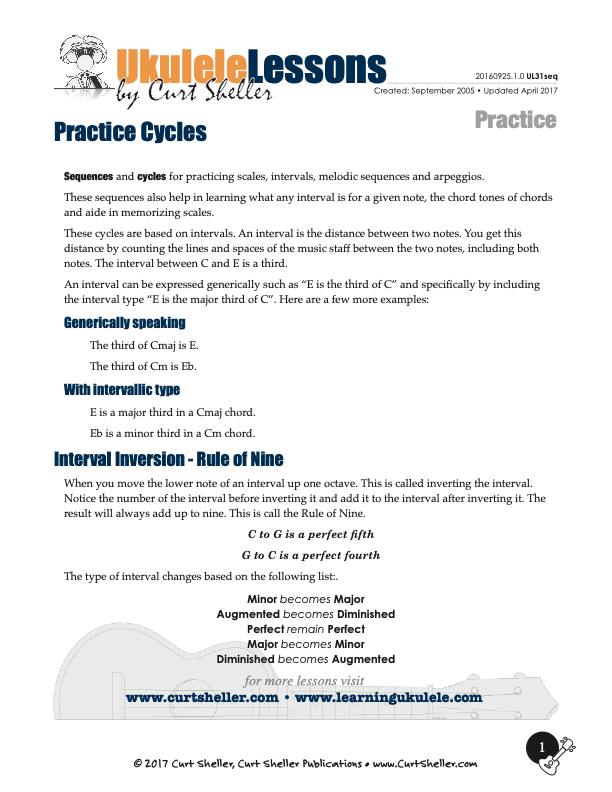On ukulele there aren't many positions where you can play a one octave scale from the root to octave. An instrument like the guitar with the additional lower strings five and six allows one to play a one octave scale in multiple positions in the basic 4-fret, 4-finger position. On ukulele there might be one or two depending on the scale and the key - and whether your using a low string four tuning. This lesson offers a practical approach to practicing your scales on ukulele.
On ukulele there aren't many positions where you can play a one octave scale from the root to octave.
Playing a one octave scale from the root to the octave on the ukulele is limited in terms of available positions. Unlike the guitar, which has additional lower strings (five and six), allowing for multiple positions to play a one octave scale within the basic 4-fret, 4-finger position. On the ukulele, depending on the scale, key, and tuning (whether you're using a low string four tuning), there might be only one or two positions available.
To improve your proficiency in single note playing, here are a few practice techniques to consider when playing scales. Ideally, you should strive to play any phrase, lick, riff, or melody, starting from any finger, within any octave, and on any string. Acquiring this level of versatility demands dedicated effort, but it's a worthwhile long-term objective.
- Ascending lowest note to the highest note of the scale position. This is where knowing the notes of the fingerboard really is beneficial.
- Descend from the highest note to the lowest note within the scale position.
- Vary the rhythm by using both long and short notes.
- Explore in ALL 15 keys. There are no common keys for scales, scales can start on any root — any key.
- Explore the most common intervals of 2nds, 3rds, and 6ths. And, ultimately, all intervals.
Every Finger, Every String
Getting your fingers to listen and obey your inner ear and thoughts is akin to wrangling a group of unruly cats. They simply refuse to cooperate and follow instructions as desired. It demands an abundance of patience and unwavering determination.
Back in the early stages of learning and practicing, many players, myself included, often neglected the exploration of playing melodies, scales, licks, or riffs starting from any finger on any string. It's not that we were oblivious to the benefits; it simply appeared to be an overwhelming task, particularly on a guitar boasting six strings. Nevertheless, I managed to surmount these obstacles and achieve substantial progress with my studies with Chuck Anderson. On the ukulele, which offers a mere three or four strings, the effort required is noticeably reduced. I encourage you to at least try this approach with melodies, as there is great value in doing so. It helps strengthen the connection between your inner ear and your hands.
Frank Vignola says: Learn 200 songs — the melodies, and you'll have no problem learning to improvise.

Finally, you need to be able to play starting on any note, on any string and starting on any finger. This is where my book The Six Secrets of Ukulele Fingering comes into play. It's more of an exploration and discover, and NOT the memorizing of any additional new patterns. It's navigating the various possible pathways available on the fingerboard that really open up the fingerboard.
Think of fingering as a series of pathways. When you learn to connect these pathways, there are benefits not only to technique, but also to creativity. All fingering on the ukulele can be reduced to 6 principles of motion. Each principle has physical and musical characteristics that you can use to improve your playing.
Related Lessons, Videos, Lesson Series, Songs, Books & Reference Charts, Resources & Assets, Workshops are below.

The six essential scales are: Blues Major Pentatonic Mixolydian Dorian Aeolian and Ionian From the six essential scales, you can get through a wide variety of traditional and contemporary music. A scale is simply a collection of pitches or notes, not really a "this is a Jazz scale", "this is a Blues" or "this is a Rock scale". It's how a scale is used that really matters not its name.

Daily Practice Material for the Contemporary Ukulele Player is an organized collection of daily practice and reference material for the contemporary ukulele player. This material can be used to develop the vocabulary and knowledge necessary for single note playing.

Learn the six fingering principles to navigating the ukulele fingerboard. Fingering is one of the most universal topics. Whether your style is Rock, Blues, Country, Jazz or Classical, these principles will improve your technique, your solos, even your sight reading. Think of fingering as a series of pathways. When you learn to connect these pathways, there are benefits not only to technique but also to creativity.

Learn to create exciting solos in a variety of contemporary styles! Scales are used to improvise, create melodies and riffs. With broad knowledge of the essential scales that are used in contemporary music and a mastery of the ukulele's fingerboard and fingering principles, you're well on your way.

Finally, learn the names of the notes of the ukulele fingerboard in C tuning .

Learn the six fingering principles to navigating the ukulele fingerboard. Fingering is one of the most universal topics. Book: Six Secrets of the Ukulele Fingering

Harmonic Analysis is the understanding of the functional sequence of chords. It is the process used to analyze the harmonic structure of a progression, song or composition. Book: Harmonic Analysis for Scale Selection and Chord Substitution

Learn to read single note melodies in the first/open position is a lot easier than you might think. Book: Ukulele – Reading Music Series – Primer

An organized collection of daily practice and reference material for the contemporary ukulele player for developing the vocabulary and knowledge necessary for single note playing. Book: Daily Practice Material for the Contemporary Ukulele
Checkout the Books & Reference Charts for additional Handy, Dandy Reference Charts.

Ukulele Fingerboard Chart for C Tuning, Low or High G – G C E A

Ukulele Fingerboard Chart for G Tuning, Low or High A – D G B E

A handy reference chart of all 15 major and relative minor key signatures. US Letter 8.5 x 11 sized (ANSI-A), A4
Checkout the Books & Reference Charts for additional Handy, Dandy Reference Charts.
A Practical Approach to Exploring Scales.









.jpg)